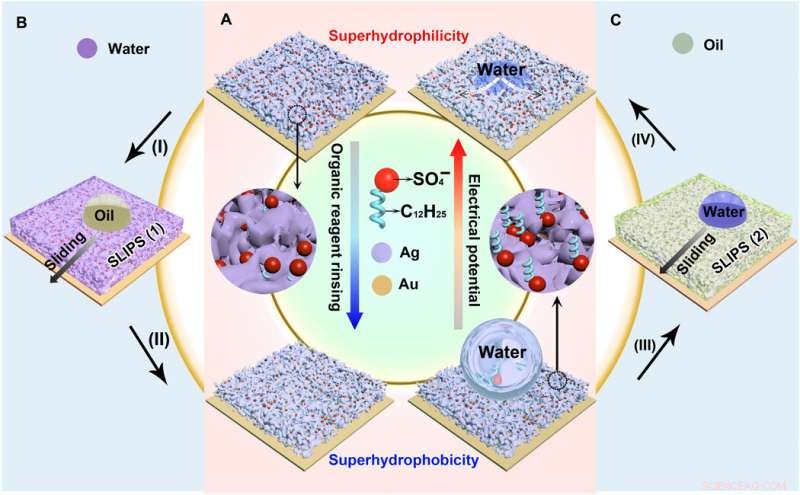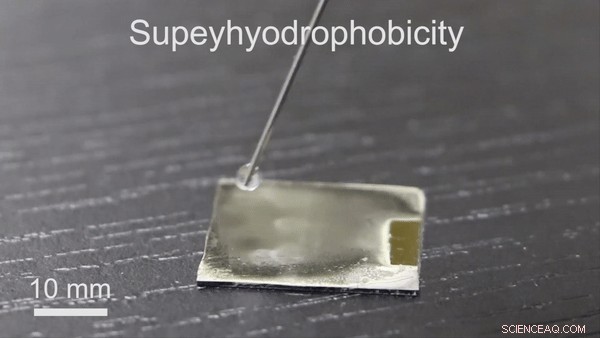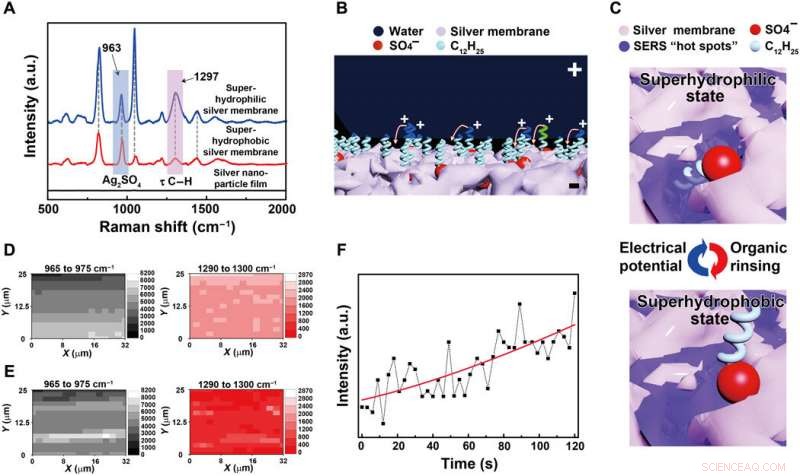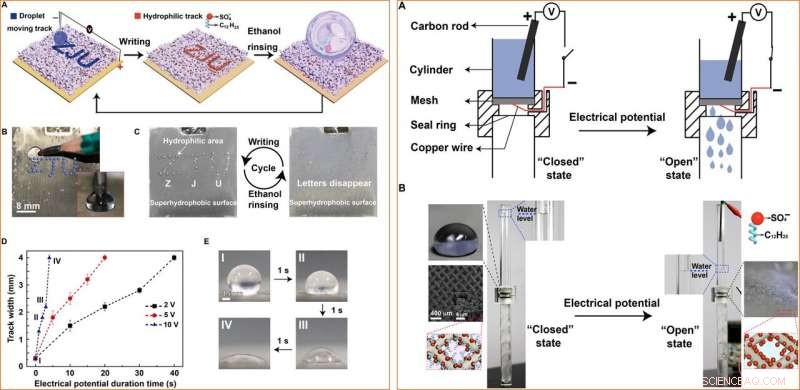
Mudança reversível de molhabilidade e repelência a líquidos das membranas porosas de prata eletrodepositadas. (A) Transição de molhabilidade reversível de super-hidrofílico para super-hidrofóbico, possibilitada pela mudança de orientação dos íons dodecil sulfato. (B) SLIPS 1 é formado pela infusão de água na membrana porosa superhidrofílica (processo I), que pode repelir o óleo. Após enxaguar com etanol (processo II), SLIPS 1 torna-se super-hidrofóbico. (C) O óleo é infundido na membrana porosa superhidrofóbica (processo III), formando SLIPS 2. A água será repelida por SLIPS 2. O óleo lubrificante será liberado do SLIPS 2 sob um potencial elétrico (processo IV), dando origem a uma membrana porosa superhidrofílica. Crédito:Science Advances, doi:10.1126 / sciadv.aax0380
As tecnologias de engenharia de materiais visam controlar a molhabilidade e a repelência a líquidos de superfícies de materiais para diversas aplicações dentro e fora do campo da ciência dos materiais. Em um relatório recente sobre Avanços da Ciência , Yue Liu e uma equipe de pesquisadores dos departamentos de Ciência e Engenharia de Materiais, e Química e Engenharia Molecular na China desenvolveram um conceito geral para desenvolver superfícies metálicas porosas com excepcionalmente poderoso, recursos do interruptor de molhabilidade. Para projetar as novas superfícies, eles usaram um método extremamente simples, processo de deposição eletroquímica de uma etapa. A equipe ativou a mudança de molhabilidade e manipulou as propriedades repelentes de líquidos, alterando a orientação dos íons dodecil sulfato que foram ionicamente ligados a membranas metálicas porosas durante a eletrodeposição. As superfícies resultantes com molhabilidade ajustável podem reter diversos lubrificantes sob demanda nos poros para criar superfícies porosas com infusão de líquido personalizadas para uma variedade de propriedades repelentes de líquido. A equipe de pesquisa demonstrou as aplicações de membranas porosas com infusão de líquido para criptografia, para controlar a transferência de gotas e para a captação de água. Adicionalmente, os cientistas de materiais revestiram a membrana porosa de prata em uma malha de cobre para projetar um comporta de líquido anti-incrustante para permitir a passagem de óleo ou água mediante solicitação.
Na engenharia de materiais, pesquisadores pretendem desenvolver propriedades interfaciais reversivelmente comutáveis para diversas aplicações de sistemas microfluídicos, para a coleta e transporte de água, bem como separadores, sensores e sistemas de entrega de drogas. Os cientistas de materiais estudaram extensivamente essas superfícies comutáveis de umedecimento controladas por meio de estímulos externos, incluindo luz, valor do PH, tratamento térmico e eletroquímico, contra-íons e potenciais elétricos. No presente trabalho, Liu et al. relatou um extremamente simples, abordagem de eletrodeposição de uma etapa para projetar superfícies metálicas porosas com capacidades de comutação de molhabilidade robustas acopladas a excelentes propriedades repelentes de líquido que diferiam dos mecanismos relatados anteriormente para projetar um novo interruptor de molhabilidade.
Umectabilidade reversível de engenharia em superfícies porosas eletrodepositadas
Liu et al. modulou a orientação dos íons dodecil sulfato que se ligaram ionicamente à membrana porosa durante a eletrodeposição para estabelecer a molhabilidade da superfície reversivelmente ajustável. Por exemplo, quando as cadeias de dodecil apontam para fora, a membrana reteve a superhidrofobicidade (ódio à natureza). Em seguida, os pesquisadores usaram potenciais elétricos para fazer a transição da molhabilidade do estado superhidrofóbico (ódio à água) para o estado superhidrofílico (amante da água). Eles confirmaram as mudanças na orientação da superfície iônica usando medições de espalhamento Raman aprimorado pela superfície (SERS). Com base na evolução induzida por orientação iônica de superfícies porosas eletrodepositadas, a equipe de pesquisa prendeu firmemente diversos lubrificantes dentro dos poros para formar diferentes "superfícies porosas com infusão de líquido escorregadio (SLIPS)" para múltiplas aplicações.

Fabricação e caracterização das membranas porosas da fita. (A) Imagem do microscópio eletrônico de varredura da membrana porosa de prata eletrodepositada. Detalhe:imagem ampliada. (B) A altura média aritmética da rugosidade das membranas de prata eletrodepositadas a 1,5 V para tempos diferentes. (C) As curvas I e II são os ângulos de contato com a água nas membranas porosas de prata como preparadas e tratadas com etanol preparadas a 1,5 V para tempos diferentes, respectivamente. Curva III são os ângulos de contato com a água no filme de nanopartículas de prata tratado com etanol eletrodepositado em soluções aquosas de nitrato de prata puro. (D) A transição de molhabilidade de super-hidrofílico para super-hidrofóbico pode ser completada por tratamento com 25 reagentes orgânicos comumente usados. (E) ângulos de contato e ângulos de roll-off da membrana porosa de prata superhidrofílica após ser tratada por uma mistura de água e etanol em diferentes proporções de volume. (F) A transição de molhabilidade de super-hidrofílico para super-hidrofóbico e de volta para super-hidrofílico por 10 ciclos. (G) A morfologia da membrana porosa permanece inalterada após 10 ciclos de transição de molhabilidade. As barras de erro em (C) a (F) são obtidas com base em pelo menos cinco medições independentes. Crédito:Science Advances, doi:10.1126 / sciadv.aax0380
A nova técnica terá um potencial significativo em diversas aplicações termoquímicas devido à sua simplicidade de engenharia, versatilidade e baixo custo. Para formar o interruptor reversível de molhabilidade, os pesquisadores primeiro eletrodepositaram uma membrana porosa de prata em um wafer de silício coberto de ouro em uma solução eletrolítica contendo nitrato de prata e dodecil sulfato de sódio (SDS). Conforme o cronograma de eletrodeposição aumentou, a rugosidade da membrana aumentou gradualmente, depois de quatro minutos, a membrana resultante era superhidrofílica. With the assistance of organic liquids as well as with water containing a minute amount of ethanol (one percent in volume), the scientists could induce the transition of wettability from superhydrophillic (or superoleophillic; water loving) to superhydrophobic (water hating). The instant transition indicated high sensitivity of the membrane toward organic reagents. The water contact angle also increased (hydrophobic character) when they simply exposed the silver porous membrane to an ethanol atmosphere (i.e organic reagent).

The superhydrophobicity of the organic reagent–treated silver porous membrane. Crédito:Science Advances, doi:10.1126/sciadv.aax0380
Understanding the mechanism of wettability transition
The research team conduced systematical studies to reveal the underlying mechanisms of wettability transition, first by using Fourier transform infrared spectroscopy (FTIR) and X-ray photoelectron spectroscopy (XPS) for surface analysis. They proved the existence of SDS ions within the silver porous membrane to form a monolayer structure similar to a previously well-studied surface. Liu et al. hypothesized that hydrophobic dodecyl chain tails hid inside the pores of the freshly prepared silver porous membrane– prompting the silver membrane to initially demonstrate hydrophilicity due to the exposed, hydrophilic sulfate heads.
When the superhydrophillic surface then encountered organic reagents such as ethanol, the hidden dodecyl chain tails changed orientation to face the organic liquids due to their mutually strong affinity. Due to challenges of proving the changing orientation of the dodecyl chains on the rough porous membranes using conventional scanning tunneling microscopy or atomic force microscopy, the team used SERS. The SERS intensity, which mapped the interactions between dodecyl ionic chains and silver sulfate surface, confirmed the transition that facilitated the membrane wettability switch. When they removed the dodecyl ions using oxygen plasma treatment, they eliminated the wettability switch from the silver porous membrane.

Mechanism of the reversibly switching interfacial properties. (A) SERS spectra of the silver porous membrane at superhydrophilic state and superhydrophobic state and the electrodeposited silver nanoparticle film in pure silver nitrate aqueous solutions. The SERS peaks located at 963 and 1297 cm−1 are assigned to silver sulfate and the torsional vibration mode (τ) of C─H in the dodecyl chains, respectivamente. a.u., unidades arbitrárias. (B) Schematic illustration of the orientation change of the dodecyl chains under an electrical potential. Positive charges will accumulate at the tips of the dodecyl chains contacting water, rotating them toward the negatively charged silver porous membrane. (C) Schematic illustration of the SERS intensity evolution of the dodecyl chains at different wetting states. At hydrophilic state, dodecyl chains are exposed to the SERS “hot spots” existing within the pores of the silver membrane, resulting in strong SERS signals. At hydrophobic state, the dodecyl chains are far away from the SERS hot spots, demonstrating weak SERS signals. (D and E) The SERS mapping results of silver sulfate and the dodecyl chains when the porous membrane is superhydrophilic and superhydrophobic, respectivamente. (F) The intensity evolution of the 1297-cm−1 SERS peak from dodecyl chains at a specific location as the electrical potential was applied to the superhydrophobic silver porous membrane (photo credit:Yue Liu, Zhejiang University). Crédito:Science Advances, doi:10.1126/sciadv.aax0380
Applications of the technique—encryption and liquid transfer
Having developed a new concept to engineer reversible wettability, the research team developed a variety of applications such as information encryption, droplet transfer, liquid-repellence, fog harvesting, and smart liquid gate as well as oil/water separation. For information encryption, Liu et al. dragged a pencil that behaved as a cathode electrode immersed in a droplet, upon the superhydrophobic surface connected to the positive pole of the power supply to write the letters "ZJU." The surface then transformed to maintain hydrophilicity and when the scientists exposed the surface to water or steam, the encrypted invisible words were revealed due to surface attachment of water droplets. They could change the speed of encryption and remove the hydrophilic track using ethanol to recycle the surface multiple times for reuse. By changing surface properties, they could also induce conditions of hydrophobic encryption. The research team then made use of strong surface adhesion to transfer water droplets across from superhydrophillic surfaces using ethanol-treated silver porous membranes, where droplets adhered on top of the silver membrane for easy transfer.
Harnessing the liquid-repellent properties for additional applications
Depois disso, the research team designed silver porous membranes to change from superhydrophillic SLIPS1 (slippery liquid-infused porous surfaces) to superhydrophobic SLIPS2 to form a repeatable cycle between SLIP1 and SLIP2 surfaces for a desired timeframe. The work described here were a first in study to engineer such complex wetting and liquid-repellent properties with potential for dynamic adjustment to match diverse lubricants. Adicionalmente, bioinspired by the Namib desert beetle that used patterned hydrophilic and hydrophobic elytra (hardened forewing) to retain or remove water droplets, Liu et al. patterned stripes of SLIP2 for excellent water repellence. They engineered surfaces to adhere water molecules for nucleation on hydrophilic surfaces upon exposure to water mist for outstanding fog harvesting efficiency.

LEFT:Application in encryption. (A) Schematic of the information encryption process. A water droplet is dragged by a pencil connected to the negative pole of a power supply to write letters ZJU on the superhydrophobic surface connected to the positive pole of the power supply. The track turns hydrophilic. When the porous membrane is immersed in water or exposed to water steam, the ZJU letters will appear. Ethanol rinsing can turn the hydrophilic track superhydrophobic, allowing for repeatable usage. (B) The setup for the encryption application. Inset:A pencil behaving as a cathode immersed in a droplet sitting on the superhydrophobic surface. (C) Repeatable usage of the silver porous membrane in encryption applications. (D) The track width as a function of the duration time at 2, 5, and 10 V. The error bars are obtained on the basis of five independent measurements. (E) Photographs of the track created at 10 V for different times (photo credit:Yue Liu, Zhejiang University). RIGHT:Application as a smart liquid gate. (A) Schematic of the setup of the smart liquid gate. (B) At the beginning, the mesh is at the “closed” state because the silver-coated copper mesh is superhydrophobic. Once the mesh is triggered by an electrical potential, it turns to the “open” state, and water starts to pass through the mesh. Inset:The image of a water droplet on and the orientation of the dodecyl sulfate ions on the silver-coated copper mesh at the closed and the open state, as well as the microstructure of the silver-coated copper mesh (photo credit:Yue Liu, Zhejiang University). Crédito:Science Advances, doi:10.1126/sciadv.aax0380
Próximo, the scientists electrochemically coated the silver porous membrane onto a copper mesh for applications as a smart liquid gate. While the original superhydrophobicity prohibited the passage of water, when they applied a negative electric potential to the copper mesh, the surfaces became superhydrophilic for the immediate passage of water. The surface property could be interchangeably engineered by exposure to ethanol vapor, for reuse. Liu et al. similarly engineered silver-coated copper meshes for selective water/oil separation, which differed from existing prototypes for efficient oil and water isolation and transfer.
Desta maneira, Yue Liu and colleagues developed a general concept to engineer metallic coatings with switchable wettability liquid repellence using a simple, one-step electrodeposition method. They harnessed the changing orientation of dodecyl sulfate ions ionically bonded to the electrodeposited porous metallic membrane, with organic reagent treatment or an external electric potential to facilitate the wettability switch. They recycled the wettability transition more than 10 times in the study, while forming diverse SLIPS for a variety of applications. The extremely simple and cost-effective materials engineering approach to form switchable wettability and liquid-repellant materials surfaces will have promising applications in liquid/thermal-related fields within and beyond materials science.
© 2019 Science X Network